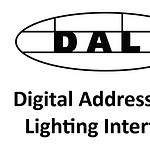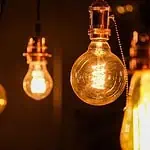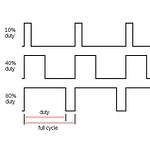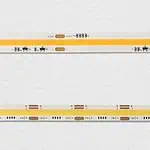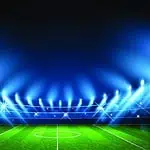Lighting control is an intelligent lighting technology that allows you to adjust the amount, quality and characteristics of light in a specific area. Dimer is a good example of lighting control.
The two main types of dimming controls used in outdoor lighting fixtures are DMX (Digital Multiplexing) and DALI (Digital Addressable Lighting Interface). To save energy, they use automated controls. However, both types of dimming controls are unique and different from each other.
Are you excited to learn more? Let’s start by understanding what these controls mean.
What is DMX?
DMX512 is a system for controlling lights but it can also control other things. “Digital Multiplex” tells you how it works from the name itself. Like a time slot, the packets that make up most of a protocol tell which devices should get data. In other words, there is no address and no information about it. In this case, the address is determined by where the packet is.
In reality, the process is straightforward. You can make electrical connections with 5-pin XLR connectors, and the interface in a balanced line pair (with 0 V reference). You can send the bytes and bits to a serial port of 250,000 bps. The RS-485 standard is a type of electrical interface.
It’s important to note that “512” in “DMX512” is also very memorable. This number shows that a packet can contain up to 512 bytes of data (513 are sent, but the first is not used). One package can hold all of the information in a DMX universe.
If each light fixture only supports basic dimming for a single color, like white light, then a single data byte can control a light fixture and offer up to 255 levels of brightness, from off (zero) to fully on (255), this means that you can control 512 devices.
A typical RGB control scheme for red, green, and blue light fixtures needs three data bytes. In other words, you can only control 170 RGB devices because a packet (and, by extension, the DMX universe) can hold only 512 usable data bytes.
For more detailed information, you can read Everything You Need to Know About DMX512 Control.
What is DALI?
DALI stands for “Digital Addressable Lighting Interface.” It is a digital communication protocol to manage lighting control networks in building automation projects. DALI is a trademarked standard that is used all over the world. It makes connecting LED equipment from many manufacturers easy. This equipment can include dimmable ballasts, receiver and relay modules, power supplies, dimmers/controllers, and more.
DALI was made to improve the 0-10V lighting control system by adding to what Tridonic’s DSI protocol could do. DALI systems let the control system talk to each LED driver and LED ballast/device group in both directions. Meanwhile, 0-10V controls only let you talk to them in one direction.
The DALI protocol gives LED control devices all the commands. DALI protocol also gives communication channels they need to control building lighting. It is also scalable and can be used for simple and complicated installations.
For more detailed information, you can read Everything You Need to Know About DALI Dimming.
Similarities between DMX and DALI
DMX and DALI are similar in some ways, making them useful in different situations.
- Light controllers
You need a control panel for all the electricity between each group of light fixtures. These are meant to let DALI users control fading, but DMX uses a controller that sends information back to the central controller. These control panels can be used for many things, like fading and changing colors.
RS422 or RS485 controllers are used for specific interface controls for DMX.
- Distance of operations
While DMX and DALI use different kinds of wiring, they work in the same range. Both let you connect the lights to the main controller up to 300 meters away. This means that the main control board needs to be put in the best place. You shouldn’t be able to go more than 300 meters in any direction. This is where the fixtures are linked to the high mast lights. Even modern super domes are about 210 feet in diameter, which makes it possible to put lights in all areas.
- High mast lights
With these two controllers, lights on tall mast poles can be turned on and off even though the speed of operation can be affected by differences in wiring. The DALI system will need two light fixtures per control unit for high mast lighting, and DMX will need a different interface controller for each light bank.
- Off-field lights
These lights connect to the lights in the stands and other stadium areas. One of these might be a fade control that is turned down just enough so that people can still walk up and down stairs. Turning on the house lights when a team scores a goal can highlight a big win.
Differences between DMX and DALI
There are distinct differences between DMX and DALI, designed to determine whether they are suitable for a given application. Some of these differences are outlined in the table below.
| DMX | DALI | |
| Speed | Fast speed control system due to the | Slow speed control system |
| Number of connections | Can have a maximum of 512 connections | Can have a maximum of 64 connections |
| Type of control | Centralized control system | Decentralized control system |
| Color control | Using the specialized RGB-LED, you can handle color control using DMX | It does not support color change; only fading of the lights |
| Cable requirement | With the maximum of 300m coverage, it requires a Cat-5 cable requirement which is also attributed to its fast speeds | Still with a maximum of 300m coverage, it uses a two-wire connection setup |
| Automatic requirement | Cannot perform automatic addressing | Can perform automatic addressing |
| Dimming control | Easy to use | A bit complex and might require some training before use |
- Color control
DMX is the only system that lets you change colors. Also, a specific LED bulb that can change colors must be used. The best choice is the RGB-LED, though there might be better options for field lighting. These lights can be pointed at both the audience and the playing area. Since the DALI control system was made to only work as a fader, it can’t change the lights.
- Speed control
When using the DMX controller, there is a clear difference in how fast things move. The fixture gives you information in real-time through a simple interface. Because of the way the wiring is set up, this information is sent back faster, making it possible to control the lights immediately. The DALI method, which uses two wires, has a delay of up to 2 seconds. A longer delay time doesn’t make it harder to control the brightness, but it takes longer to compare the results.
- Dimming
The DALI’s simple dimming control comprises a single slider and an on/off button. With the DMX, you have the same options for delays, FX, and preprogrammed time fades. The main difference is that DALI has a warning light for lights that aren’t working right, and the DMX doesn’t have this function. When it comes to basic dimming control, the DALI controller is easier to use than the DMX controller in many ways.
- Controller
The DALI controller looks like a slide controller. The controller is a black box with a switch that turns it on and off and some sliding controls. The DMX controller panel goes further than that with controls that slide and preset buttons. It also lets you control the lighting to change and adapt the colors. Again, the two main controllers are very different from each other. Different light patterns and FX can be made with the DMX’s built-in presets.
- Number of lights
This is the most significant difference between these two. DALI can control 64 lights, but DMX can control up to 512 lights and fixtures individually (1 channel per light). There is a perfect reason for this, though. The DMX lighting system controls different colored lights that can be used to make stunning effects. Now, sporting events often use flashing lights to get people excited. But DALI works best when used with both on-field and off-field lights.
- Warning indicator lights
When a light bank doesn’t work, the intelligent design of DALI makes a warning light come on right away. The light either doesn’t respond or doesn’t work right. Dimming LED lights can be a sign that the light controller has broken. This is a nice built-in feature that hopefully never gets used. The DMX system is set up so that the interface system gets information in real-time, whether or not the lights are responding.
- Wiring differences
The interface wire that the DMX uses is a CAT-5 cable. This is how information is sent to and received from the LED fixture. Also, it ensures that the information about how lights work is quick and easy to understand. You can also change the lighting using the control panel switches. Even though DALI only uses two wires, it takes longer for the signal to get to the main controller.
- Effect control
The DMX controller is the clear winner in making effects that stand out. It has extra effects that can turn any game into an LED light show. When you add LEDs that change color, you get a lot of great options for making a high-intensity game. It can also be used with music to make certain parts of a sporting event stand out. It’s a great lighting controller that can make a game feel more prominent.
Applications for DMX and DALI
- Roads and Highways
Lighting is an essential part of driving. Good lighting allows drivers and people walking to see well on the road. High mast lights are set up at regular intervals along the network of highways to ensure that the lighting is the same everywhere. DMX lighting control is used on roads and highways because it is easy to use.
- Sport Fields
You need different kinds of light for various sports, which means that DALI and DMX are good choices for lighting sports fields. The goal is to ensure that both the audience and the players have a good time and that the lights don’t take away from that.
For example, the DALI controller and high mast poles would work best for a tennis court. This is true because the tennis court is small, making it easier to control each light individually.
The best way to improve the spectator’s experience on the field is to use DMX to control the lights. DMX works quickly, and the effects are impressive because the lights’ color can change instantly, making it enjoyable for the audience.
Both of these light controllers are excellent choices for sports fields. Depending on the lighting needs, some sports fields have switches in different places around the area. Most of the time, the DALI controls are not on the field, but the DMX controls are.
- Commercial Settings
In business places like airports, tall mast poles need to have a lot of lights on them. The controls for the light are also critical. Also, everyone at the airport needs enough light, including the pilots. In business settings, both types of light controls are used. Most of the time, DMX is recommended for areas that need constant lighting, while the DALI control system is better for areas that need the light that can be changed.
Factors to Consider When Choosing between DMX and DALI Lighting Systems
- Installation lead time
A trained electrician must set up DMX and DALI systems. The main controller must be at most 300 meters from where the wiring is going. This includes adding the fader control, which lets your LED light fade in and out correctly. The CAT-5 wiring interface must be joined with special wire connectors if the DMX system is used. It will take some time to connect all the lights to work correctly.
- Type of color-changing lights
LED lights can change colors only with the DMX system, but your stadium must decide which RGB-LED light to use. These lights could be spotlights, floodlights, or a mix of both. Thanks to the DMX system, you can connect up to 170 fixtures (3 channels per RGB bulb), giving you much room to grow. You can make any color you want with these lights by mixing three colors. Because the light temperature (in Kelvin) is unique to sports lights, they can’t change it.
- The amount of wiring involved
A professional electrician in a stadium will know that wiring often needs twice as much as what is required. Before wiring starts, each light must be checked to ensure it has the proper connection. This is where most of the lead time will be used, more than anything else. This will also take time to set up because the DALI system uses two cables to connect to each fixture.
- The cost of adding more lights
When you spend money on sports lighting, you get a long-term plan for getting your money back. LED lighting gives a good return on investment over a long period. If LED lighting is expected to work perfectly for more than 20 years, the costs could be considered high. Still, it costs more to build a sports stadium than it will last. LED sports lights are already 100% cost-effective because they save up to 75%–85% on energy costs.
FAQs
Most businesses choose dimmable drivers as their standard choice for smart and energy-efficient lighting. Dimmers save energy by letting users change how bright the light is to their liking. Most of the time, people use 0-10v analog dimming systems and DALI dimming systems.
Digital Multiplex (DMX) is a protocol that controls things like lights and fog machines. Since the signal is unidirectional, it can only move from the controller, or first light, to the last light.
Even though DMX is used to control smoke and haze machines, video, and an increasing number of home lighting fixtures that use LED lighting, it is mainly used to control lighting for entertainment.
Each piece of automated lighting needs its DMX channels in a specific part of the DMX universe. With this channel range, you can directly control every aspect of the light (often between 12 and 30 channels).
Cabling. If the fixture flickers or doesn’t work, the first and easiest thing to do is check the wiring. Many lighting and connection problems happen when people use broken or wrong cables.
Basic Lighting controls
Dimmer Switches
Sensors
DALI Lighting Control System
Networked Lighting Control
The DMX specification says the maximum length is 3,281′, but in the real world, every link can weaken the signal. Keep your cable run to no more than 1,000 feet.
Conclusion
Over time, the technology used to control lights has gotten better. DMX and DALI are in the lead. Both of these systems can work with most LED lights. Your system choice should be based on the goal you want to reach, and the lighting project must fit the needs of the control system you choose. Another vital thing to consider is how much it will cost to set up. A lighting expert can help you decide which of the two lighting systems is best for you. Also, keep in mind that it is possible to combine both controllers into a single system.
LEDYi manufactures high-quality LED strips and LED neon flex. All of our products go through high-tech laboratories to ensure the utmost quality. Besides, we offer customizable options on our LED strips and neon flex. So, for premium LED strip and LED neon flex, contact LEDYi ASAP!
